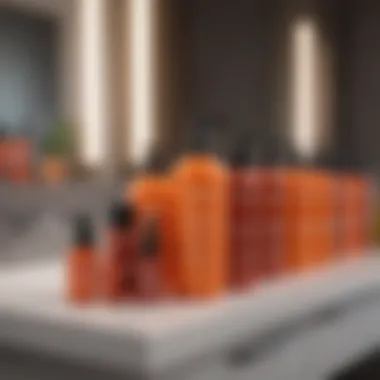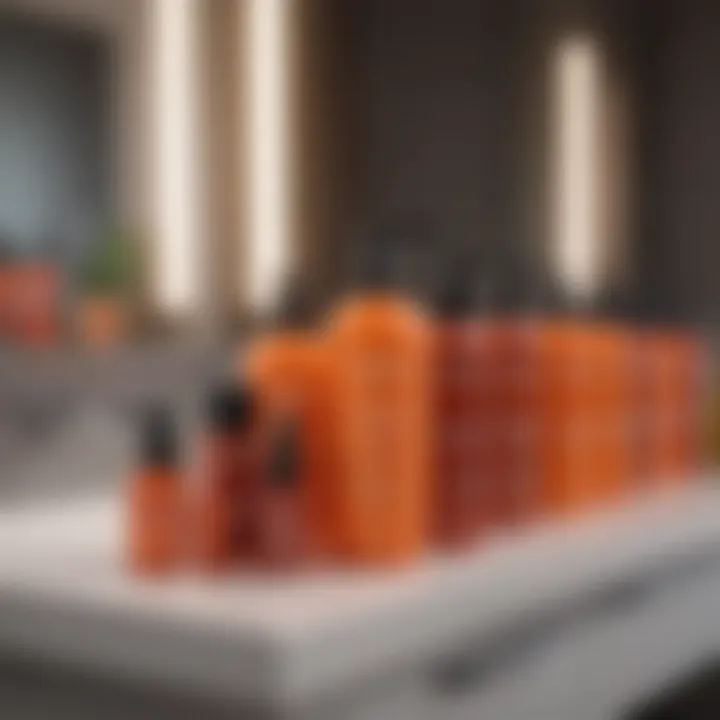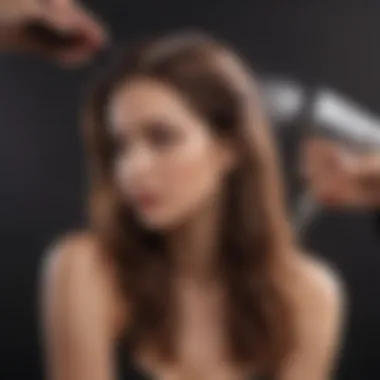Best Heat Protection for Hair: A Comprehensive Guide


Intro
In the world of haircare, safeguarding strands from heat damage is crucial. With the rise of styling tools such as flat irons, curling wands, and blow dryers, the need for effective heat protection has become more significant than ever. This guide will explore various products and methods designed to protect hair without sacrificing style. Understanding how these tools affect hair will empower readers to make informed choices about their haircare routines.
Fashion Trends
Seasonal Styles
Hair trends change with the seasons, much like fashion. Each season brings unique styles that can require different heat application techniques. For instance, summer often embraces beachy waves and loose curls, achieved through hot styling tools, while winter might lean towards polished straight hair or intricate updos.
Understanding how to protect hair during these styling processes ensures that fashion choices do not come at the expense of hair health.
Influencer Inspirations
Social media influencers curate aesthetics that many aspire to achieve. Following their styling techniques often involves the use of heat tools. Observing how these personalities incorporate heat protection in their routines can provide valuable insights. For instance, influencers often share their favorite thermal protectant products, showcasing both effectiveness and style. Examining their methods can inspire women to explore heat protection while enjoying the latest trends.
Beauty Tips
Skincare Routines
Like skin, hair requires proper care. It’s essential to incorporate thermal protection as part of a broader beauty regimen. This can involve using leave-in conditioners that contain heat protectants, ensuring that hair remains moisturized and safeguarded while styling.
Makeup Techniques
While not directly related, hair and makeup are interconnected in achieving a holistic look. If hairstyling is a major focal point, ensuring that hair is protected allows for versatility in makeup styles. This can lead to experimentation with bold or subtle looks without worrying about hair damage.
Product Reviews
Trending Products
The market is saturated with heat protectant products. Some current favorites include
- Moroccanoil Perfect Defense: This lightweight spray is heat-activated, making it ideal for styling tools.
- Ghd Heat Protect Spray: Known for adding shine and reduce breakage, it works well with various styling methods.
- Tresemmé Thermal Creations Heat Tamer: A budget-friendly option that offers decent protection for daily styling.
Comparison Guides
When comparing heat protectants, consider:
- Ingredients: Look for those containing silicones, which coat the hair and provide a barrier against heat.
- Type of Product: Sprays, creams, and oils each offer different application techniques and levels of protection.
- User Reviews: Understanding experiences from others can provide insight into the product's effectiveness.
"Investing in quality heat protection products prevents future damage, ensuring your hair stays healthy and vibrant."
With this guide, women can navigate the many options available for heat protection, aligning their hairstyling practices with overall hair health.
Understanding Heat Damage
Heat damage is a critical topic in hair care, especially for those who frequently use styling tools such as flat irons, curling wands, and blow dryers. Understanding this concept not only aids in maintaining the hair’s integrity but also informs on how to properly use heat protectants. Heat can alter the hair structure, leading to weakened strands and an overall unhealthy appearance.
The importance of recognizing heat damage lies in prevention. By learning about how high temperatures affect hair, individuals can take necessary steps to protect it. This section will explore the nature of heat damage, its impact on hair, and how to identify its signs.
What is Heat Damage?
Heat damage occurs when hair is exposed to temperatures above a certain threshold, usually around 450 degrees Fahrenheit (232 degrees Celsius). This exposure breaks down the hydrogen bonds within the hair strands. When these bonds are damaged, the hair loses its natural moisture and elasticity. The result is usually frizz, split ends, and a dull appearance, making hair look lifeless.
In simpler terms, heat damage is the breaking down of the hair’s structural integrity due to excessive heat. It can be cumulative, meaning that regular high-temperature styling can lead to irreversible damage over time.
How Heat Affects Hair Structure
Hair is mainly composed of a protein called keratin. When subjected to high heat, the keratin proteins can begin to denature. This process alters the natural structure of the hair. The outer layer of the hair, known as the cuticle, can become rough and uneven, allowing moisture to escape and making the hair vulnerable to further environmental damage.
There are three primary zones of the hair that heat can affect:
- Cuticle: The outermost layer, which protects the inner structures.
- Cortex: The middle layer that contains most of the strength and pigment of the hair.
- Medulla: The innermost layer, which is not present in all hair types.
When heat damages hair, it often starts at the cuticle and can reach deeper layers with continuous exposure.
Signs of Heat Damage
Identifying heat damage is crucial for timely interventions. There are several signs to recognize that your hair may be suffering from strain caused by heat:
- Brittleness: Hair may become dry and break easily.
- Frizz: An increase in frizziness, even on non-humid days, can indicate damage.
- Split Ends: Increased occurrence of split ends is a clear signal of stressed hair.
- Dull Appearance: Loss of natural shine can be an indication that the hair is stripped of moisture.
- Tangled Hair: Difficulty in combing or styling hair may point to underlying damage.
For women who regularly use styling tools, recognizing heat damage early can make a substantial difference in hair health.
Understanding the signs allows for timely corrections. Addressing heat damage can involve powerful products and techniques designed to restore moisture and protect the hair from future harm.
The Necessity of Heat Protection
Heat styling has become a routine part of many people’s hair care regimen. Unfortunately, frequent exposure to high temperatures can lead to significant damage to the hair structure.
The necessity of protecting hair from heat cannot be overstated. Without proper protection, hair can suffer from dryness, brittleness, and breakage. Heat protectants play a critical role in mitigating these risks.
Why Use Heat Protectants?
Heat protectants are specially formulated products designed to coat the hair before styling. They create a barrier against the intense heat from tools like straighteners, curling irons, and blow dryers.
Utilizing heat protectants is essential for several reasons:
- Minimizing Damage: A good protectant helps reduce the direct contact of heat with hair strands, lowering the risk of cuticle damage.
- Adding Moisture: Many protectants also contain moisturizing elements that keep hair hydrated, combating the drying effects of heat.
- Enhancing Shine: These products can help enhance the natural luster of hair, leaving it looking healthier and more vibrant.


Incorporating heat protectants into your styling routine can be a game changer, especially for those who regularly use heated tools.
Long-Term Benefits of Protection
Investing in good heat protection is not just about immediate results. The long-term advantages are significant. Regular usage of heat protectants can lead to healthier hair overall.
Some benefits include:
- Improved Hair Texture: With continued use, hair may feel softer and more manageable due to the protective layer and moisturizing properties.
- Reduced Need for Trims: By minimizing damage, there's less split ends, which can mean fewer trips to the salon for cuts.
- Enhanced Hair Growth: Healthier hair is more likely to grow at a proper rate, as damaging heat can hinder growth cycles.
Protecting your hair is not an option; it is a necessity for sustaining its health and appearance.
Ultimately, the necessity of heat protection cannot be overlooked. It serves as the first line of defense against the consequences of regular heat usage, ensuring that hair remains strong and vibrant for years to come.
Types of Heat Protection Products
Understanding the types of heat protection products is crucial for maintaining the health and integrity of hair, especially for individuals who frequently use thermal styling tools. Selecting the right product can significantly reduce the risk of heat damage. Each type of heat protection product serves a specific purpose and may contain unique ingredients that cater to different hair types and conditions.
Sprays
Sprays are among the most popular forms of heat protectants. They offer versatility and convenience, making them a preferred choice for many. The lightweight nature of sprays allows for easy application and even distribution across the hair. Many sprays provide a protective barrier against direct heat, which is essential when using tools like straighteners and curling irons. They often include ingredients that help retain moisture, allowing the hair to maintain its natural bounce and shine.
For optimal results, it’s recommended to spray evenly onto damp or dry hair before styling. Different formulations are available, such as those for fine or thick hair types, giving users more tailored options.
Serums
Serums are typically heavier than sprays and can provide substantial protection against heat. They are formulated with oils and silicones that coat the hair, reducing moisture loss and frizz. Additionally, serums can add shine, which enhances the overall appearance of styled hair.
Using a serum can also help in detangling and smoothing hair, making it easier to style. Apply a small amount to the palms and work it into the hair, focusing on the ends where damage is often most apparent. This product is particularly beneficial for individuals with coarse or dry hair that needs extra moisture and protection.
Creams
Creams are another option for heat protection that can offer rich hydration. Unlike sprays which are lightweight, creams are thicker and can provide a deep conditioning effect. They usually work well for thick, curly, or frizzy hair, as they can help tame flyaways and improve manageability.
To use a cream effectively, apply a small amount to damp hair, concentrating on the lengths and ends. This allows for even distribution and helps ensure that the hair is prepared for thermal styling. The result is protected hair that appears smooth and polished, reducing the risk of heat-related damage.
Oils
Oils have become increasingly popular in hair care routines. They are effective in protecting against heat damage, all while providing moisture. Certain oils, like argan oil or jojoba oil, can penetrate the hair shaft, offering deeper nourishment. They create a barrier that protects against environmental stressors and reduces heat absorption during styling.
To apply oils, use a few drops in the palms and gently distribute it through the hair's mid-lengths to ends before utilizing heat styling tools. This method enhances shine and can result in healthier-looking hair.
In summary, choosing the right product type—whether sprays, serums, creams, or oils—depends on individual hair needs and styling habits. Each type offers unique benefits and helps to safeguard hair against the damaging effects of heat.
Active Ingredients in Heat Protectants
Active ingredients are crucial components of heat protectants. They determine the effectiveness of a product in shielding hair from heat damage. Understanding these ingredients helps consumers make informed choices when selecting the right product for their hair type and styling needs. High-quality heat protectants contain a combination of effective active ingredients that not only protect hair from heat but also nourish and repair it.
Silicones
Silicones are synthetic compounds widely used in hair care products. They create a barrier over the hair shaft, reducing moisture loss and providing a smooth finish. Common silicones include dimethicone and cyclopentasiloxane. These ingredients are effective in preventing heat damage by reflecting heat away from the hair. Silicones can also enhance shine and manageability. However, it's essential to choose the right type of silicone. Some silicones can build up on the hair over time, making it look greasy or dull.
Natural Oils
Natural oils are gaining popularity in heat protectants. Ingredients such as argan oil, coconut oil, and jojoba oil provide hydration and nourishment while protecting against heat. They penetrate the hair shaft and help maintain moisture balance. Natural oils also possess anti-inflammatory properties, which can soothe irritated scalp and hair. When chosen correctly, these oils can help restore hair vitality and improve overall health, making them a favorable option for heat protection.
Proteins
Proteins are vital for hair structure and strength. They play a critical role in repairing and strengthening hair that has suffered heat damage. Proteins such as keratin and silk proteins can form a protective film around the hair, preventing breakage. They also improve elasticity, making hair more resilient to heat styling. Regular use of proteins in heat protectants can contribute to healthier hair, especially for individuals who frequently use heat tools.
Vitamins and Antioxidants
Vitamins and antioxidants are essential for comprehensive hair care. Ingredients like vitamin E and C not only protect hair from heat but also combat oxidative stress from environmental factors. They enhance the overall health of hair and promote shine and softness. Antioxidants can also help in repairing previous damage. Including these ingredients in heat protectants provides additional benefits and supports long-term hair health.
"Choosing a heat protectant rich in active ingredients like silicones, natural oils, proteins, and vitamins can significantly impact hair health and appearance."
In summary, the active ingredients in heat protectants serve various purposes. Each ingredient contributes to preventing heat damage, while also nourishing and repairing hair. Being mindful of these components can help consumers select products that align with their specific hair goals.
Choosing the Right Heat Protectant for Your Hair Type
Choosing the right heat protectant for your hair is crucial for maintaining its health and integrity. Different hair types have distinct needs when it comes to protection against heat damage. It is essential to select a product tailored to your hair's specific characteristics. This not only enhances the protection but also ensures that the product works harmoniously with your hair's natural structure.
The right heat protectant can provide numerous benefits. It creates a barrier against high temperatures, minimizes moisture loss and allows for smooth styling results. Understanding the unique requirements of different hair types can lead to better choices and healthier hair overall.
Fine Hair Considerations
Fine hair tends to be more susceptible to damage from heat. When choosing a heat protectant for fine hair, lightweight formulas are preferable. Look for sprays or serums that do not weigh the hair down. Products with silicones can add a layer of protection without heavy buildup.
In this context, it's beneficial to consider:
- Spray Formulas: They disperse evenly and offer a light coating.
- Avoiding Heavier Creams: They may overwhelm fine strands, causing greasiness.
Using products designed specifically for fine hair can prevent the hair from appearing limp while still providing necessary protection against styling tools.
Thick and Coarse Hair Needs


For those with thick and coarse hair, heat protectants serve a different purpose. This type of hair often requires more intense hydration and protection due to its density. Creams and oils can be effective, as they provide moisture and slip to the hair, making it easier to manage during styling.
Important factors to consider include:
- Heavy Creams and Oils: These help in combating frizz and providing lasting protection.
- Moisturizing Ingredients: Look for natural oils like argan or coconut oil that nourish and shield the hair.
Thick hair can withstand a bit more product, and a robust heat protectant can significantly reduce damage during styling, allowing for smooth and shiny results.
Color-Treated Hair Insights
Color-treated hair often requires special attention when selecting heat protectants. The chemical processes involved in hair coloring can weaken the hair shaft, making it more prone to damage from heat. Therefore, a heat protectant that also contains color-safe ingredients is vital.
Key aspects include:
- Color-Safe Formulas: Products that specify protection for colored hair help maintain vibrancy.
- Conditioning Agents: These maintain moisture levels, reducing brittleness and breakage.
Using a heat protectant specifically designed for color-treated hair helps preserve the longevity of the color while safeguarding against heat damage.
Conclusion: Selecting the right heat protectant based on your hair type is an essential step in maintaining healthy hair. Each type of hair has distinct characteristics, and understanding these can lead to better product usage and more effective protection.
Application Techniques for Optimal Protection
Effective application techniques are crucial for maximizing the benefits of heat protectants. Proper techniques ensure that the product performs as intended, providing adequate coverage while preventing potential damage to hair. Understanding when to apply, the amount to use, and how to distribute the product properly can make a significant difference in maintaining hair health during styling.
When to Apply Heat Protectant
Applying heat protectant at the right time is essential for enhancing its effectiveness. Ideally, heat protectants should be applied on clean and dry hair just prior to using any heat styling tools. This helps to create a barrier between the hair and the heat, minimizing exposure and reducing the risk of damage. If you are planning to use a blow dryer, it is advisable to apply the product after towel-drying your hair but before using any heat.
Regular styling tools can produce temperatures that exceed 200 degrees Celsius. If heat protectants are applied too late or on wet hair, their effectiveness can significantly diminish. Therefore, using the product when the hair is at optimum condition—dry or slightly damp—will provide better protection.
How Much Product to Use
Determining the correct quantity of heat protectant is also vital. Using too little may not provide adequate protection, while too much can weigh down the hair and cause greasiness. A good rule of thumb is to use a small amount, typically the size of a quarter, for medium-length hair. For shorter hair, a smaller amount can suffice, whereas longer or thicker hair may require slightly more.
Each product may have specific recommendations on the label, so it is beneficial to follow those guidelines. Experimenting with different amounts might be necessary because factors like hair thickness and length influence how much is needed for effective coverage.
Proper Distribution Techniques
How you distribute the heat protectant is just as important as the amount you use. To achieve optimal results, the product should be applied evenly throughout the hair. Here are some effective distribution techniques:
- Spray Technique: When using a spray, hold the can about six inches away from the hair and spray in sections, making sure to cover every strand.
- Rubbing Method: For creams and serums, dispense the product into your palms and rub your hands together to warm it up before application. This helps in better distribution. Apply it section by section, focusing on the ends and mid-lengths, as these parts are typically more prone to damage.
- Comb through: After applying the product, use a wide-tooth comb to help distribute the product evenly. This ensures that every strand is covered, providing uniform protection against heat.
"Proper distribution can dramatically increase the performance of your heat protectant, offering protection where it’s needed most."
By adhering to these application techniques, you prepare your hair to withstand heat styling while preserving its integrity. This practice can greatly contribute to healthier, more resilient hair over time.
Combining Heat Protection with Other Hair Care Practices
The integration of heat protection with a comprehensive hair care routine is crucial for maintaining hair health. Heat damage is a significant concern for anyone who regularly uses styling tools. Therefore, it is essential to consider how heat protectants interact with other hair care products and practices. This holistic approach ensures that hair remains healthy, vibrant, and resilient against damage.
Moisturizing and Conditioning
Moisturizing products form the foundation of any hair care regimen. When using heat protectants, it is vital to ensure that the hair remains hydrated. Well-moisturized hair is more resilient against the damaging effects of heat styling tools. Conditioners, leave-in treatments, and masks can help provide the moisture that hair needs.
Incorporating moisturizing products enhances the effectiveness of heat protectants. When the hair cuticle is smooth and hydrated, it can better withstand the heat. The following are benefits of moisturizing:
- Improves Hair Texture: Moisturized hair appears shinier and softer.
- Prevents Breakage: Hydrated hair is less prone to breakage and split ends.
- Enhances Tool Efficacy: Heat styling tools work better on well-moisturized hair due to reduced friction.
Consider using products that include natural oils, as they can penetrate the hair shaft and provide necessary nutrients. Products containing argan oil or coconut oil are particularly effective.
Regular Trims and Hair Health
Regular trims are a fundamental part of maintaining good hair health. No matter how diligent one is with heat protection, split ends and damage can still occur over time. Trimming hair every six to eight weeks can significantly reduce the appearance of heat damage and maintain overall hair shape.
This practice is particularly crucial for those using heat frequently. By removing damaged ends, hair appears healthier and more manageable. Moreover, regular trims can prevent the spread of damage along the hair shaft. The benefits of regular trims include:
- Eliminates Buildup of Damage: Cutting off damaged ends prevents further deterioration.
- Promotes Growth: Regular trims encourage healthy hair growth by keeping the ends fresh.
- Maintains Style: A well-kept haircut enhances overall appearance.
In summary, combining heat protection with consistent moisturizing and regular trims creates a strong defense against heat damage. This strategy not only preserves the efficacy of heat protectants but also contributes to healthier hair overall, making it an essential area of focus for anyone committed to their hair care routine.
Evaluating Product Effectiveness
In the realm of hair care, particularly when it comes to heat protection, evaluating product effectiveness is essential. With so many products available, understanding how to assess their performance can help you choose the best options for your specific needs. This section focuses on critical elements of evaluating heat protection products, the advantages they offer, and important considerations to keep in mind.
First, the effectiveness of a heat protectant is often influenced by its active ingredients. Knowing the active ingredients and how they function is vital. For example, silicones can provide a barrier against heat, while natural oils may offer moisturizing benefits. Each ingredient plays a role in protecting hair. Thus, understanding these components can lead you to make more informed choices.
Additionally, effectiveness varies depending on individual hair types and needs. A product may work well for one type of hair but may not yield the same results for another. Therefore, testing different options can be beneficial. Taking the time to evaluate ensures that you select the right product for your particular hair condition.
Benefits of evaluating product effectiveness include maintaining the integrity of your hair, preventing long-term damage, and optimizing your styling routine. Furthermore, consistently using effective products can enhance the overall quality of your hair, leading to healthier results over time.
Conducting a Patch Test
A patch test is a simple and effective method to evaluate how your skin and hair will react to a product before full application. This is especially crucial for people with sensitive skin or allergies. The process involves applying a small amount of product to a discrete area of the scalp or hair and monitoring for any adverse reactions, such as itching or redness.
Conducting a patch test not only helps prevent potential allergic reactions but also provides insights into how the product interacts with your unique hair and scalp. Tracking your hair’s response over 48 hours is a good rule of thumb. If irritation occurs, it is advisable to discontinue use. However, if the test shows no adverse effects, you can proceed with confidence to use the product as intended.


Long-Term Observations
Long-term observations of product effectiveness allow for a deeper understanding of how well a heat protectant functions over time. This involves monitoring the condition of your hair after using the product consistently for several weeks. Look for changes in texture, strength, and overall health. Assess whether your hair feels more resilient against heat tools or if there is reduction in split ends, dryness, or frizz.
Moreover, it is helpful to notice if your hair styling routine improves, meaning that styles last longer without damage. Keeping a simple hair diary may aid in tracking any progress or changes in your hair condition related to the use of heat protectants. Moreover, consider consulting with a professional stylist for further evaluation of your hair’s health over time.
"The best way to ensure your hair remains protected is through consistent, long-term evaluations of the products you use. Your hair health is a reflection of those choices."
In summary, by conducting patch tests and making long-term observations, you can gain valuable insight into the effectiveness of heat protection products. This knowledge empowers you to make better-informed decisions regarding your hair care regimen.
Latest Innovations in Heat Protection
Innovations in heat protection have become vital in the ever-evolving beauty industry. As styling tools continue to advance, the need for effective heat protectants has increased. These products not only minimize damage but also support overall hair health. By exploring the latest advancements, women can make informed choices about the products they use.
Technological Advancements
In recent years, there has been a marked shift toward technological improvements in heat protection products. One significant advancement is the incorporation of smart technology that adjusts the intensity of heat according to the hair's specific needs. Smart heat protectants can analyze hair texture and moisture levels, ensuring optimal protection during styling. This personalized approach means less risk of damage and better outcomes on all hair types.
Another advancement includes the development of heat-activated ingredients. These ingredients work effectively when exposed to heat, providing enhanced protection. They can form a protective barrier around each hair strand, locking in moisture and reducing frizz. This is particularly beneficial for women with curly or textured hair, who often struggle with heat-related issues.
Safeguarding Environmental Factors
Environmental factors can significantly impact hair health. Pollution, humidity, and UV exposure play a role in both hair damage and effectiveness of heat protectants. Consumers are increasingly aware of the need for products that also combat these external stressors. Modern heat protectants now combine thermal protection with pollution defense and UV filters. This holistic approach offers added benefits, making one product serve multiple purposes.
Another aspect of innovation involves sustainable formulations. Many brands are now focusing on eco-friendly ingredients and packaging. This shift not only safeguards hair but also aligns with growing consumer preferences for sustainable beauty products. Utilizing natural components such as plant-based oils and extracts can provide effective protection without harmful chemicals.
"The right heat protectant does not just shield your hair from heat; it also counteracts environmental damage, ensuring lasting health and shine."
In summary, latest innovations in heat protection are about more than just preventing heat damage. They integrate technology and environmental awareness into hair care, enabling informed choices that promote well-being.
Common Misconceptions About Heat Protection
When discussing the subject of heat protection for hair, misconceptions often arise that can misinform users about the necessity and effectiveness of protective measures. These misunderstandings can lead to improper hair care practices, which eventually may harm hair health. Understanding these common misconceptions can guide individuals towards making more informed decisions about hair styling and protection.
Heat Protectants Are Optional
A prevalent idea is that heat protectants are not really needed. Some believe that as long as they use a quality styling tool, their hair will be safe. This assumption is misleading. While high-quality tools can minimize damage, they cannot completely negate the effects of heat. Studies have shown that repeated exposure to high temperatures can weaken hair structure, leading to breakage and loss of shine. Using a heat protectant creates a barrier that reduces potential damage and strengthens hair over time.
"Absence of heat protectants may lead to irreversible heat damage, affecting hair integrity and health."
The choice to skip heat protectants may seem trivial, but regular stylers can suffer significant damage later. Therefore, opting for a heat protectant is not just a suggestion; it is essential for maintaining healthy hair.
More Product Equals More Protection
Another misconception is the belief that using more product translates to better protection. Many individuals may pile on heat protectants, thinking this will offer extra defense against heat. However, oversaturating hair can lead to buildup that weighs hair down and makes it look dull. Effective heat protection does not correlate with the quantity of product used but rather with its formulation and application method.
Using the right amount is crucial. A small amount, properly distributed, can be more beneficial than excessive application. High-quality products are designed to have specific concentrations of active ingredients that effectively protect hair without the need for excessive use. Therefore, understanding the right measure for application can lead to healthier outcomes for hair.
Reader Insights and Community Contributions
The Importance of Reader Insights and Community Contributions
In the realm of hair care, understanding diverse experiences enhances the conversation surrounding heat protection. Readers often encounter varying challenges depending on their hair types and lifestyles. Gathering insights from these individuals fosters a communal knowledge base. This becomes essential not just for personal improvement, but to offer help to others navigating similar issues.
Another aspect is the shared experiences of different products. Many heat protectants exist, and what works for one person may not yield the same results for another. User insights provide essential information on effectiveness, texture, and smell, which can be critical in making informed decisions. Reading about actual results helps to demystify products, transforming abstract claims into tangible outcomes.
Community contributions also lead to a sense of belonging among users. Online forums or social media platforms, including Reddit or Facebook, become vital spaces where individuals share their stories. This connectivity can empower users to try new methods or products, building their confidence in hair care practices.
Real User Experiences
User experiences can be quite enlightening. Many women (and men) often share their trials and errors with heat protectants in various online communities. Some users may emphasize their struggles with finding the right product initialy. For example, a user might mention trying multiple sprays before finally discovering the effectiveness of a specific brand like TRESemmé Thermal Creations.
Such testimonials can guide others who are contemplating a similar purchase. They often include critical details, like how long the product lasted and the results after repeated use. For instance, someone might note that using Moroccanoil Treatment not only protected their hair but also improved its overall appearance.
It's also common to see stories about how products can perform differently depending on one’s styling tools. A user might report that a certain cream worked well for flat irons but fell short for blow drying. These nuances found in real user experiences help other readers avoid mistakes and select the best products for their specific situations.
Expert Opinions
Expert opinions carry weight because they blend knowledge and experience. Hair professionals such as stylists or trichologists possess the insights that can greatly enhance product selection and usage. For instance, professionals often stress the importance of applying heat protectants consistently, regardless of hair type.
According to experts, certain ingredients provide better protection against damage inflicted by heat tools. Stylists frequently recommend products that contain silicones, which can create a protective barrier. This protective barrier helps to prevent moisture loss during styling, leading to healthier strands, as noted by a prominent stylist in publications like Britannica.
Another common recommendation is to always prioritize the right application technique. Experts underscore application on damp hair for optimal results, detailing that this can lead to improved heat distribution. Information like this is invaluable, as it provides a scientific basis for using products effectively.
In summary, incorporating reader insights and expert contributions creates a well-rounded approach to understanding heat protection for hair. It enriches the discussion and aids readers in navigating their hair care journey effectively.
Ending: Prioritizing Hair Health
In this guide, we have emphasized the critical importance of heat protection for maintaining healthy hair. Hair is often subjected to various heat styling tools, making it vulnerable to damage. Thus, a proactive approach to safeguarding hair integrity should be a priority for anyone who uses these tools routinely. Heat damage can lead to dryness, brittleness, and split ends, which are difficult to remedy once they occur. Additionally, over time, neglecting the use of heat protectants can result in more permanent changes to hair structure.
Investing in good heat protection products is not merely a recommendation; it’s a necessary step in any hair care routine. Products designed for heat protection not only help in minimizing damage from styling tools but also can improve the overall aesthetic of hair. Silicones, natural oils, and proteins found in these products can work together to form a barrier that reduces moisture loss and protects hair cuticles. Ultimately, the right heat protectant can enhance shine, reduce frizz, and promote a healthier appearance.
Recap of Key Points
- Heat protection is essential for preserving hair health against damage from styling tools.
- Choosing the right product based on individual hair type is crucial.
- Application techniques can influence the effectiveness of heat protectants.
- Ongoing care, including moisturizing and regular trims, complements heat protection and ensures overall hair health.
- Awareness of product ingredients contributes to making informed choices.
Encouragement for Responsible Hair Care
As we conclude, it is vital to cultivate a responsible hair care routine. Prioritizing hair health goes beyond using heat protectants. It means being conscious of all aspects of hair care— from the products used to the frequency of heat application.
Regularly evaluate your hair’s condition and adapt your care practices as needed. Share experiences and insights with the community, as collective knowledge enhances individual practices. Women of all ages should remember that responsible hair care can lead to healthier, more vibrant hair, regardless of styling preferences. For more insights and tips, consider engaging with expert opinions or communities on platforms like Reddit or using informative resources such as Britannica and Wikipedia.
By prioritizing hair health, you not only nurture your locks but also invest in long-term beauty and confidence.



